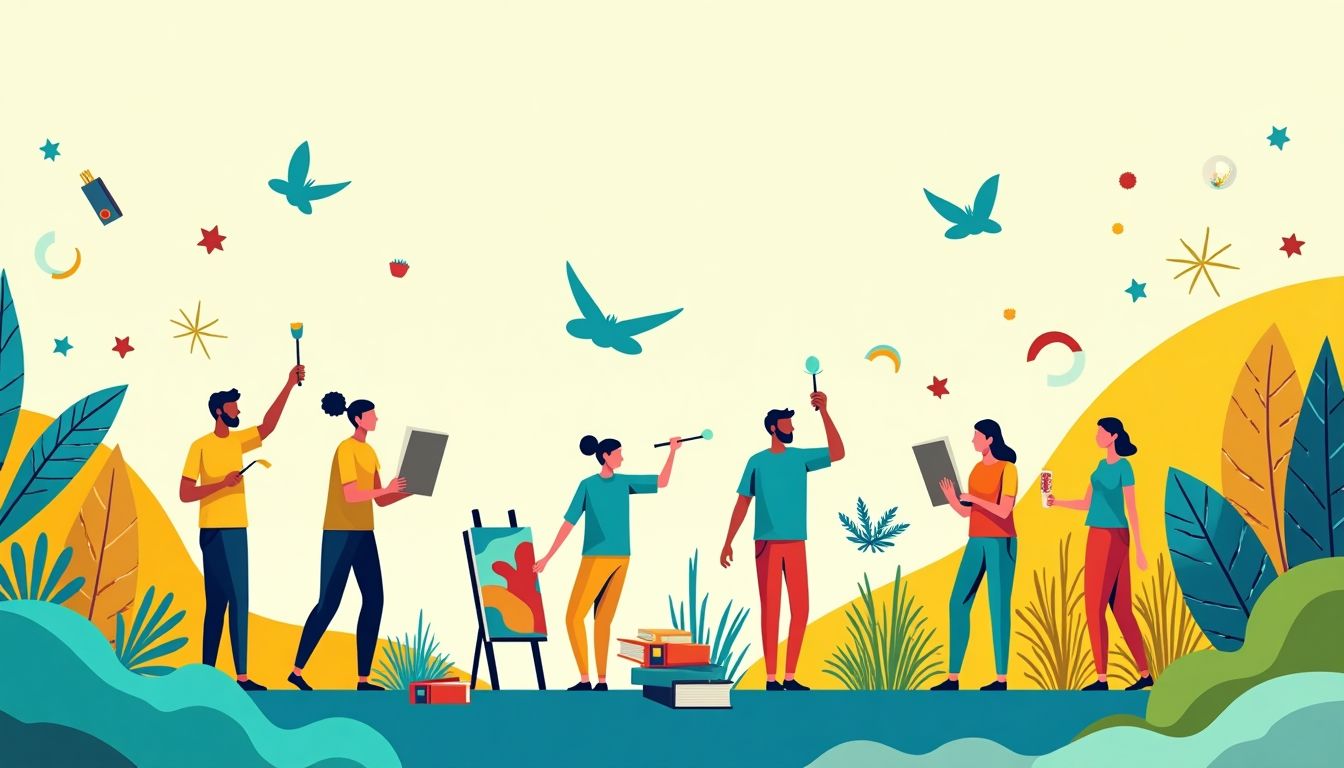Introduction: The Future of Work and Purpose
The trouble with quotes on the internet is that you can never know if they are genuine. – Abraham Lincoln. This amusing observation reminds us that authenticity, much like work, can easily be distorted in our fast-paced world. As we navigate through the fog of endless tweets and memes, it begs the question—what if we redefined authenticity in our lives through purposeful pursuits instead of the daily grind? In a time where technology and creativity converge, can we envision a life where our passions are prioritized over a paycheck, fostering greater fulfillment and innovation?
Research from visionary thinkers like Sir Ken Robinson, renowned for advocating creativity in education, and Brené Brown, who explores the power of vulnerability, has sparked conversations on the need to re-evaluate the role of traditional work in our lives. Could we, as a society of dreamers, not only survive but thrive by swapping our cubicles for canvases and spreadsheets for explorations? Prepare for a journey towards a refreshing future! It’s time to explore and challenge the nature of work—one that embraces creativity, exploration, and self-discovery.
What if the revolution to redefine work began with you?
Join me as we embark on an exploration of whether society can thrive without being shackled to traditional jobs, instead finding purpose in meaningful activities.
1. The Historical Context of Work and Creativity
To understand if we can thrive without the daily grind, we must first examine the evolution of work through various epochs of human history. From the agrarian societies that birthed civilization to the industrial revolution igniting the modern era, labor has always been a cornerstone of human development.
1.1 The Role of Creativity in Early Societies
In the earliest human cultures, creativity played an integral role in survival. The creation of tools, art, and music were essential for community bonding and resource handling. Imagine a tribe gathered around a fire, using rhythm and sound to strengthen bonds—these creative expressions were vital! They weren’t just passing time; they were building community ties that proved essential for survival. Creativity was not just an afterthought; it was woven into the fabric of daily life.
1.2 The Shift to Industrialization
The industrial revolution marked a pivotal change, valuing repetitive tasks over creative expression. Work shifted from the hands of artisans to the machines of factories. This shift produced efficiency but often at the cost of creativity. Workers found themselves stuck in a routine, chasing the clock instead of their passions. The wondrous inventions that paved the way for modern society came with an unexpected downside—our love for creativity was locked away in a dusty toolbox. This impact on societal values prompted many to wonder: what is work without joy?
2. The Psychological and Emotional Impact of Work
The importance of understanding how our jobs affect our minds and hearts can't be overstated. Let's face it: many of us dread the Monday morning alarm, feeling as if we've entered a never-ending Groundhog Day of endless meetings and deadlines. Who needs that kind of stress? Well, it turns out that traditional work can lead to some serious mental health problems. Research shows that burnout rates are skyrocketing, leading to stress, anxiety, and a range of other emotional challenges. But what if we turned the tables and started living a life focused on our passions rather than just trying to earn a paycheck? Buckle up; it gets interesting.
2.1 Burnout and the Quest for Fulfillment
Burnout is like a sneaky monster hiding under the bed—it may not seem scary at first, but once it creeps up on you, it can take over your life. According to the American Psychological Association, burnout affects over 77% of the workforce, causing fatigue, cynicism, and feelings of ineffectiveness. It's not just tiredness; it's like running a marathon, and your legs can't take another step. With the rise of remote work and the blurring of boundaries, finding balance can feel like searching for a needle in a haystack.
In contrast, choosing passion-filled projects or community service can lead to greater fulfillment. Studies indicate that people who engage in activities they love have better emotional health, feel more engaged, and are overall happier. Speaking of community service, volunteering with organizations like The Red Cross can provide a much-needed boost of joy and purpose to our lives.
2.2 Benefits of Purpose-Driven Living
Imagine waking up and leaping out of bed, excited about what the day holds. Sounds dreamy, doesn't it? Well, you may be surprised to learn that chasing your passions can significantly enhance mental well-being. Research by the American Psychological Association suggests that when people spend time on purpose-driven activities, they report feeling more satisfied and less stressed. It's as if life sprinkles fairy dust on our daily routines!
Engaging in arts, outdoor exploration, or learning something new can improve cognitive function and emotional resilience. The more we explore what ignites our passions, the more equipped we become to tackle life’s challenges head-on. Flame on, purpose-driven living!
3. Reimagining Society's Values: From Productivity to Purpose
Alright, folks, it's time for a culture shock! Ready to rethink everything? Society’s obsession with productivity has turned us into relentless workaholics, validating our worth based on how many emails we send or how fast we can finish a report. It's time to hit the brakes and turn our attention to purpose and individual growth. Let’s be clear: working harder doesn’t always mean working smarter! It’s about creating value in our lives and our communities.
3.1 Tactics for Cultural Shift
To kickstart a cultural transformation, we need a serious shift in mindset. What if we prioritized long-term goals that focus on personal development over corporate profits? Sounds radical, right? Introducing frameworks for societal narratives can help lay the foundation for new values. Think of it like organizing a community potluck—everyone brings a unique dish, symbolizing their individual strengths and passions. Imagine if our schools, workplaces, and even our governments fostered this way of thinking!
For instance, organizations like TED promote ideas worth spreading, encouraging people to share innovative concepts that challenge the norm. Incorporating purpose-driven activities into educational institutions can create future generations more interested in curiosity than constant competition.
3.2 Case Studies of Purpose-Driven Communities
Let’s take a look at some inspirational case studies that showcase communities operating in these innovative ways. One prime example is Ashoka, an organization that works to promote social entrepreneurship globally. They empower individuals who tackle social challenges creatively—think of them as the superheroes of societal change!
Another inspirational community is the burgeoning tiny house movement, where people prioritize simplicity, sustainability, and self-sufficiency over climbing the corporate ladder. Residents live intentionally, focusing on needs rather than wants. Mind you, building a tiny house doesn’t mean you’ve given up—you’ve embraced a new form of living!
These communities remind us that we can strive towards purpose-driven living and create environments that nurture creativity. Who knew breaking free from the daily grind could be so refreshing?
4. The Role of Lifelong Learning and Exploration
As we reevaluate our relationship with work, the importance of lifelong learning becomes evident. Lifelong learning is not just about studying for a degree or taking a few workshops. It's an ongoing pursuit that encourages curiosity and personal growth. It enables us to adapt, innovate, and find fulfillment beyond traditional employment scenarios.
4.1 The Benefits of Lifelong Education
Research shows that lifelong education can lead to a more meaningful life. Here are some benefits:
- Personal Growth: Continuous learning promotes critical thinking and problem-solving skills.
- Improved Mental Health: Engaging in learning activities can reduce anxiety and depression.
- Career Flexibility: Acquiring new skills makes you adaptable in a rapidly changing job market.
- Social Connections: Learning environments foster community and collaboration among like-minded individuals.
In addition, a report from the UNESCO Institute for Lifelong Learning reveals that societies investing in lifelong education see increased economic growth and social cohesion. Imagine being able to choose courses that genuinely resonate with your passions, rather than drudging through mandatory requirements.
4.2 Exploration as a Form of Engagement
Exploring new places and ideas fuels creativity, drive, and a sense of purpose. Whether traveling overseas or exploring your local neighborhood, the act of discovery can invigorate your spirit. Here are ways exploration enhances engagement:
- Cultural Understanding: Immersing yourself in different cultures helps broaden your perspective and empathy.
- Creativity Boost: New environments and experiences can ignite the creative spark in you.
- Adventurous Learning: Learning through travel is hands-on and memorable, aiding retention of information.
To highlight this point, consider the work of the National Geographic Society, which emphasizes how exploration can energize educational practices. Their programs encourage not just travel, but also deeper global knowledge while fostering curiosity.
5. Art and its Transformative Potential in Society
Art has historically been a powerful force in connecting individuals to their purpose. It allows for expression, creativity, and even social change. By embracing arts in daily life, we can foster a society less reliant on traditional work structures. Art inspires communities and provides a common language that unites diverse individuals.
5.1 Art as a Medium for Individual Expression
Arts provide avenues for personal expression and reflection, promoting mental health and community connection. Here’s how engaging with art benefits individuals:
- Emotional Release: Creating or appreciating art aids in processing feelings and experiences.
- Community Building: Art connects people, helping them share stories and perspectives.
- Skill Development: Engaging in artistic pursuits fosters new skills that can be rewarding and fulfilling.
According to the Americans for the Arts, art education not only enhances creativity but also helps improve overall academic performance and social skills.
5.2 Social Change Through Artistic Endeavors
Numerous movements throughout history demonstrate how art can inspire and mobilize communities toward change and new values. Notable examples include:
- The Harlem Renaissance: A cultural movement that celebrated African American art, literature, and music, promoting racial pride and awareness.
- Social Justice Murals: Artistic expressions in streets often highlight societal issues, inspiring grassroots movements for change.
- The #MeToo Movement: Art has played a critical role in raising awareness and voicing concerns over sexual harassment and abuse.
Art isn’t just for galleries and museums; it can transform lives on the streets and within community centers. Consider looking at organizations like Street Art News, which highlights the powerful role of street art in advocating for social change.
6. AI Solutions: How Would AI Tackle This Issue?
In an age where technology continues to advance at breakneck speed, it’s imperative that we harness the power of artificial intelligence (AI) to create a society that prioritizes purpose and passion over the daily grind. Imagine a world where AI becomes not just a tool, but a partner in the quest to uplift human experiences. This section explores how AI can enhance learning, drive creativity, and facilitate community-building efforts, ultimately leading to a more fulfilled and engaged society.
6.1 AI-Enhanced Lifelong Learning Platforms
Picture an adaptive learning platform that customizes education based on individual interests and learning styles. Platforms like Khan Academy and edX have already made strides in this direction. Programs could employ AI algorithms to analyze user performance and recommend tailored resources, courses, and experiences. This technology would help learners engage deeply with their subjects, heightening motivation and enhancing retention. As a result, education transforms into a lifelong journey, rather than a finite phase of life.
6.2 Discovering Artistic Talents through AI Algorithms
Consider a scenario where AI helps unleash the creativity within us. Platforms such as Artbreeder use machine learning to analyze artworks and generate innovative pieces based on user preferences and input. This not only helps undiscovered artists find their voice but also fosters collaboration among diverse communities. Imagine cultural hubs working together globally, producing art influenced by multiple perspectives. As AI supports our efforts, we can democratize the arts, giving everyone the chance to create and share their talents.
6.3 Community Engagement through AI
AI can also facilitate community building by identifying shared interests among individuals and designing experiences that bring them together. Social networks like Meetup already allow people to connect over common hobbies and passions. Enhanced with AI, these platforms could suggest groups, projects, and initiatives based on users' preferences and geographical locations. This would lead to unique collaborations, partnerships, and events to foster social connections, ultimately uplifting individuals and communities alike.
Conclusion: Envisioning a Society of Dreamers
As we step into a future painted with the vibrant colors of purpose and creativity, we envision a society not just surviving, but thriving. By embracing the transformative power of AI, we have the potential to redefine our understanding of work and fulfillment. Beyond the hustle and grind lies a world rich with opportunities for personal growth and collective achievement. This future doesn't merely belong to dreamers; it’s a realm where each individual contributes meaningfully to a tapestry of shared experiences. To realize this vision, we must commit to fostering a culture of lifelong learning, exploration, and artistic expression. Through cooperation, innovation, and the continuous pursuit of passion, we can create a society alive with the possibilities of human potential. Isn't it time we challenge the status quo, reject the limitations of conventional employment, and cultivate a vibrant world where dreamers and doers alike can thrive?
FAQ
Q1: Can society function without traditional jobs?
Yes, society can thrive without traditional jobs by focusing on
purpose-driven activities
that encourage creativity, personal growth, and community engagement. These activities can lead to happier, healthier individuals who contribute to society in meaningful ways.
Q2: What are purpose-driven activities?
Purpose-driven activities are pursuits that prioritize personal fulfillment, creativity, and community service over earning a paycheck. Examples include:
- Artistic endeavors like painting or music
- Volunteering or community service
- Exploring new places and cultures
- Lifelong learning through courses or workshops
Q3: How can AI contribute to a purpose-driven society?
Artificial intelligence (AI) can enhance our ability to engage in purpose-driven activities. Here’s how:
- Personalized Learning: AI can create tailored learning experiences based on individual interests and needs, helping people develop their passions.
- Artistic Tools: AI can help discover and nurture artistic talents by providing tools for creation and collaboration.
- Community Building: Through AI, individuals can connect and cooperate on projects that fosters shared goals and creativity.
Q4: What role does lifelong learning play in this vision?
Lifelong learning is essential for a purpose-driven society. When people keep learning and exploring new ideas, they can:
- Stay engaged and curious
- Adapt to changing interests and opportunities
- Develop new skills as needed
- Create connections with others in their learning journeys
Q5: How can communities initiate this transformation?
Communities can begin the shift to a purpose-driven society by encouraging activities that promote creativity and collaboration. Here are some starting points:
- Host Workshops: Organize art, writing, or technology workshops to spark interest and participation.
- Start Discussions: Create forums or social events where community members can share their passions and ideas.
- Form Partnerships: Work with local schools, nonprofits, and businesses to support initiatives focused on lifelong learning and engagement.
Q6: What are some examples of purpose-driven communities?
Several communities have successfully embraced purpose-driven approaches:
- Burning Man: A temporary community in Nevada that fosters creativity, self-expression, and collaboration.
Check it out on their official website. - Toledo, Ohio: This city has developed numerous art initiatives promoting local artists and community-driven projects. Learn more from the Toledo Community Foundation.
- Jubilee Commons: A gathering place where local artists, makers, and thinkers can collaborate and share ideas. Explore more about it on their website.
Wait! There's more...check out our gripping short story that continues the journey: Pénélope Victoire
Disclaimer: This article may contain affiliate links. If you click on these links and make a purchase, we may receive a commission at no additional cost to you. Our recommendations and reviews are always independent and objective, aiming to provide you with the best information and resources.
Get Exclusive Stories, Photos, Art & Offers - Subscribe Today!





























Post Comment
You must be logged in to post a comment.